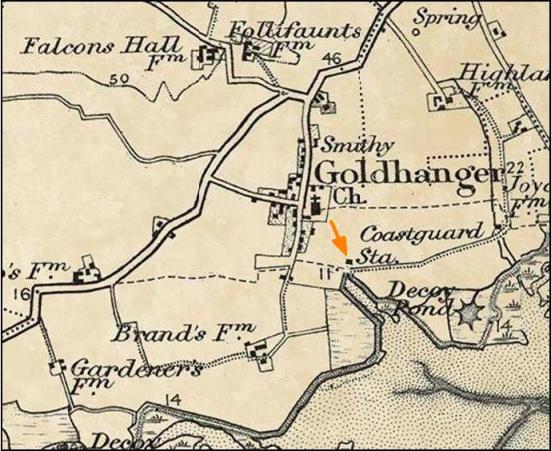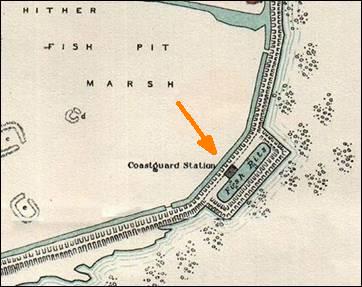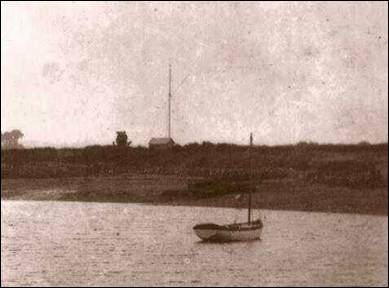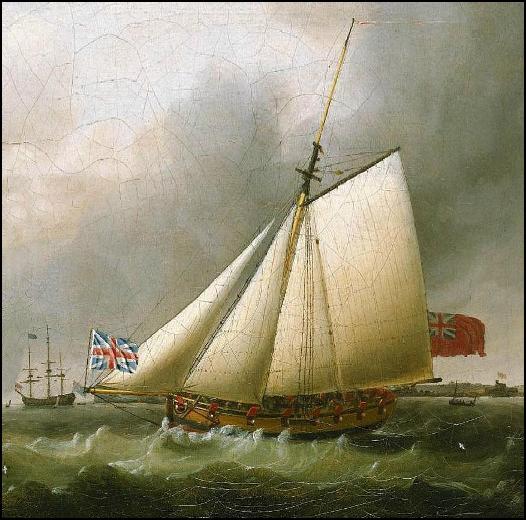Smuggling in Goldhanger and the Blackwater
contents
o Smuggling around
the Blackwater
History of
Smuggling
Smuggling in the past is a
subject that attracts universal fascination stories about it have been heavily
romanticised and distorted. However, a wealth of factual information exists
from official records. Goldhanger has a particular historical interest
in the subject as the village is located in a prime position to have been part
of the Free Trade and the stories
that have been passed down, together with official records, confirm that the
village and the Blackwater were renown for being involved. The Coastguard
cottages, built in 1822, still stand as a lasting legacy to that involvement.
Much has been written about
smuggling and there are two primary sources of material: Collectors of Customs
were not only responsible for collection of revenue but were also responsible
for recording all smuggling activities, and were meticulous in their
documentation, which remains archived in county record offices. These reference
books used extensively this source of information and are quoted in the
article:
Smuggling in Essex, by
Graham Smith, 2005,
The Smugglers Century, by
Harvey Benham, 1986
Goldhanger - an
Estuary Village, by Maura Benham, in 1977
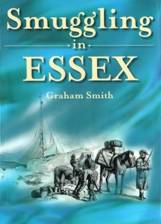
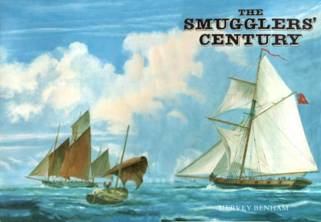

In contrast authors of
fictional works from the Victorian period onwards saw smuggling as an ideal
basis for adventurous, heroic, romantic stories. The violence involved was also
portrayed in these stories, such as in the semi-fictional History of
Margaret Catchpole. More surprisingly perhaps, the smuggling association
with violence was seen a suitable subject for children stories, such as in Goldhanger
Woods. These books are typical of this approach:
Mehalah, by Revd Baring Gould, 1880
Goldhanger Woods, by M & C Lee, 1887
Mistress of Broad Marsh, by Alfred Ludgater, (a
friend of Baring Gould)
History of Margaret Catchpole, by Revd Richard
Cobbold, Suffolk,1847
Cargo of eagles, Margery
Allingham 1966
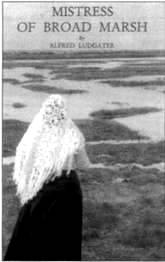
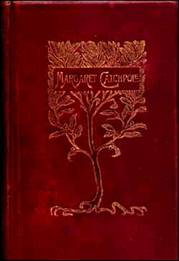
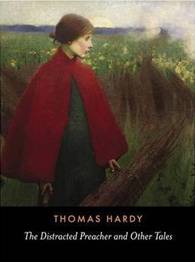
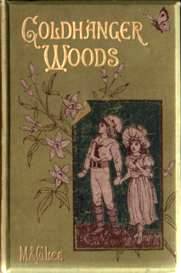
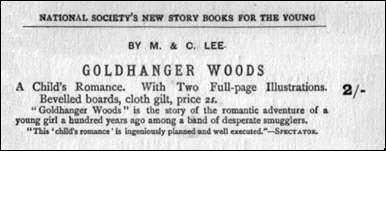
It is known that the
authors, Catherine & Mary Lee, had connections with, and stayed at Tiptree
Priory, which is on the edge of Heath which is well known for its association
with smuggling.
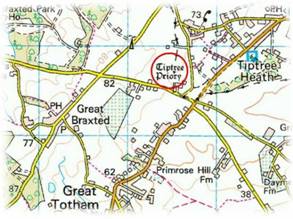
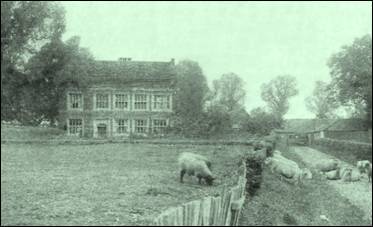
Tiptree Priory in the early
1900s
Although there are only a
few references in Goldhanger Woods to Goldhanger or indeed Tiptree,
there are several associations within the book:
o The `big house` in the book
is set on edge of a gorse covered common used by gypsies.
o Smugglers are known to have traded
on the common (see many references later to Tiptree Heath)
o "Goldhanger" is
referred to variously in the book as a village, and not just as a wood.
The complete book can now be read online within
Google Books at... Goldhanger Woods
online
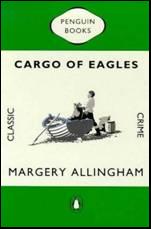
Margery Allingham wrote her
last book entitled: Cargo of Eagles
in 1966 with a
smuggling/romantic theme: Detective, Albert Campion sets out to plumb the
secrets of Saltey, an ancient hamlet on the Essex marshes (said to be based on
Tollesbury). Once the haunt of smugglers, now it hides a secret rich and
mysterious enough to trap all who enter - and someone in the village is willing
to terrorise, murder and raise the very devil to keep that secret to
themselves. With the help of a love-lorn historian, and a one-woman avenging
army, Campion uncovers murder.
In the days before photography the adventurous image
of smuggling also made it a fertile territory for the artists of the time. . .
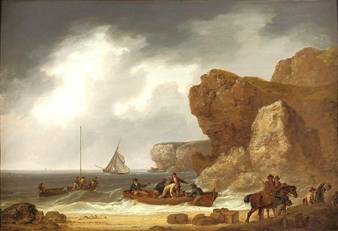
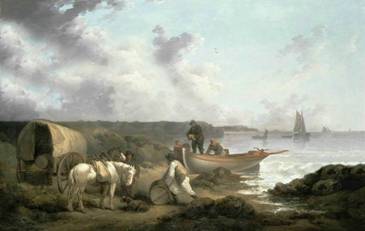
Smugglers Unloading
Contraband by George Morland
Moreover, there are an
abundance of paintings and drawings of revenue cutters, as revenue officers
were very enthusiastic about acquiring the latest and fastest vessels and were
equally keen to record them in artworks which can still be admired today. . .
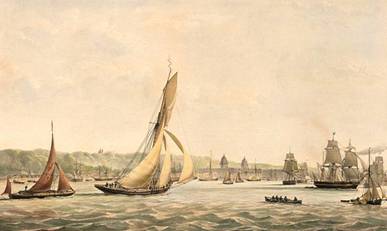
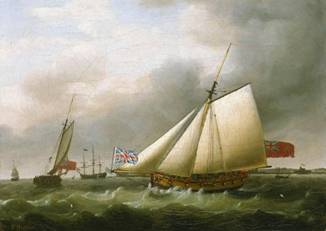
Vigilant
Revenue Cutter on the Thames
In the past a surprising number of goods had excise
duty placed on them that resulted in these goods being smuggled, at over the
centuries they have included:
Imports: Alcohol and tobacco, salt, tea, coffee,
sugar,
nutmeg,
pepper, silk, lace, leather, soap, Bayes & Says (Baize & serge wool)
ship
parts: bowsprits, sails
Exports: wool & flour
Coastwise Traffic: coal, slate, marble, oysters,
salt
During wars and the immediate post-war periods many
rationed goods were also smuggled.
The relationship between
smugglers, the authorities and the public was always strained, and for various
reasons those in the rural areas appeared to have sided with the smugglers. . .
o Perhaps through poor
communications many people didn`t understand why goods were being taxed or for
purpose the money raised was being used for.
o At the time of the peak
smuggling activity there was very little government support for those in rural
areas, ie no welfare state, state pension, little road maintenance, sanitation,
etc.
o In fact, most of the money
raised was spent on fighting wars overseas and developing the colonies in the New World, so if ordinary people knew,
they probably would not agreed with it. Some of the major imports from land
acquisitions the New World such as tobacco and rum were subsequently heavily
taxed on import, with the consequential increase in smuggling.
o In the middle of the 15th
century laws was passed requiring all import and export goods to pass through a
small number of recognised ports that had a resident Revenue Officer. Maldon
was the only port in the Blackwater that qualified. Many workers in other
coastal locations resented their livelihood taken being away in this manner.
o Working people didnt have a
vote or have any other contact with authority and the law makers.
o Working class people werent
used to being taxed. There was no income tax or PAYE, purchase tax or VAT, as
in a cash and bartering oriented society the collecting and policing such taxes
was impossible. Taxing imported goods at a port was a practical solution for
the authorities and smuggling was effectively tax evasion and a direct
consequence. In the 1600s there was a Hearth
Tax and in the 1700s there was a Window Tax, but these only affected the
better off who had more than one hearth and more than six windows.
o In the later part of the
1600s a salt tax was introduced, with local Salt Officers appointed to collect
the tax and control salt production. This which substantially increased the
price of salt and led to much smuggling of salt around the coast and in the
blackwater.
see... Salt extraction in
the Blackwater
o Smuggling was classed as unpaid
tax by the authorities and a debt not a criminal offence so the police were not
involved.
o Most people, including the
poorly paid farm workers and fishermen, knew that a proportion of the fines
imposed was being shared amongst the revenue officers: "half for the king,
half for crew". Author Charles Lamb wrote: The "Honest Smuggler robs
nothing but the Revenue". Even parish churches were frequently used to
temporary storage of contraband, so priests, if not involved, "turned a
blind eye".
As excise duty and the
number of goods effected increased over the centuries, smuggling became an ever
increasing problem to the authorities, and the preventative measures,
organisations and legislation progressively evolved to keep up, but probably
always lagged behind the scale of the problem. In an attempt to control
smuggling stringent shipping laws were introduced over the centuries:
o
All imports & exports were required to pass through a recognised
port
o
Boat hovering close to the
shore became illegal
o
A Salt Tax and Salt Officers were imposed to control salt production
and collect the tax
o
A legal limit was set for the length of bowsprit to ensure Revenue
cutters were faster
o
No more than 4 oars to a boat permitted
o
Half a ship's crew had to be British
o
A licence was required for all vessels, only issued if the owner had
not been connect to smuggling
o
Lighting fires on the coast was made an offence
o
Smuggler's boats were impounded, burnt or cut in half...
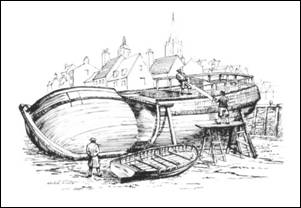
The authorities advertised rewards for information
that could lead to seizures...
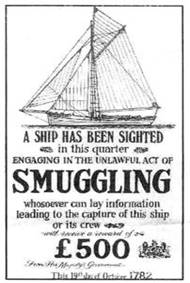
The revenue men needed to be armed with the latest weapons and the swivel gun was state-of-the-art for the Kings Cutters....
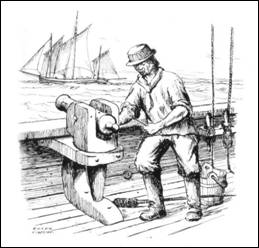
At the same time the smugglers developed their own
tools to help them avoid the revenue men, such as this special “Spout Lamp”
that only projected light in one direction and was used for discreet signalling
and “Spirit Bubbles” to measure alcohol strength in remote locations...
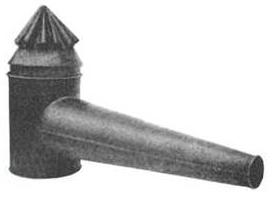
A Spout Lantern
Spirit Bubbles
Smugglers caught at sea made
ideal impress candidates as they already had experience of the sea. Revenue
cutter crews were rewarded with 'head money'. The Impress Service, or more
commonly called the press gang, was employed to seize men for employment at sea
in British seaports. Impressment was used as far back as Elizabethan times when
this form of recruitment became a statute and later the Vagrancy Act 1597, men
of disrepute could be drafted into service. In 1703, an act limited the seizure
of men for naval service to those under 18, although apprentices were exempt
from being pressed. In 1740, the age was raised to 55. Impressment was last
used at the end of the Napoleonic wars in 1815...
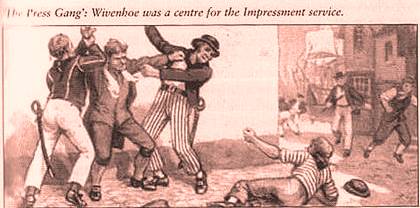
Smuggling on the East Coast
The pattern of landing and
distribution in England along the east coast changed over the centuries with
evolving policies of prevention. The Suffolk coastline was well-supplied with
good beaches which suited the open landing of contraband, a technique that
worked well in the 18th century, while the Preventives dozed in the distance,
or were open to bribes. As the net tightened in the early nineteenth century,
smuggling then intensified in the estuaries and creeks of the east coast, where
the activity was less easily observed, and where tubs, also called half-ankers,
could be secretly sunk in the murky waters, for later collection.
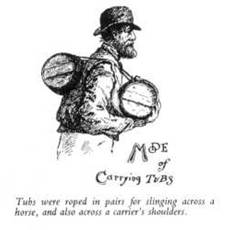
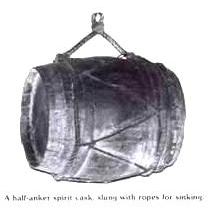
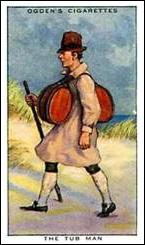
From the Chelmsford
Chronicle of 10 September 1779. . .
A correspondent informs us
that a few days since, a large smuggling vessel passed through Burnham river to
Hullbridge, where she unloaded her cargo; she mounted six carriage guns and 18
men, had on board 1,700 halves, and a large quantity of dry goods; since then
carts and horses have frequently been seen passing through Danbury, Chelmsford,
&c., loaded with goods. The Maldon custom house officers had a skirmish
with some of the smugglers, but they proved too strong for them. We hear one of
the smugglers is since dead from a wound he received in the skirmish.
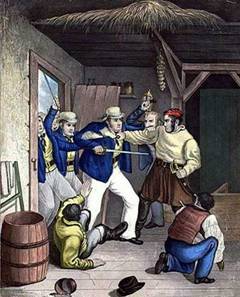
Smuggling
was associated with violence
The length of Essex coastline, with many inlets and
estuaries and damp misty conditions meant it was ideal for smuggling goods to
and from the Low Countries. Also the Essex reputation for being a source of the
ague (malaria) kept both the authorities and the wealthy away.
Smuggling around the Blackwater
An extract from the Maldon District Museum
Newsletter, Spring 2008...
As early as 1300, East Anglian wool was highly
prized was being exported and taxed. While it is usual to think of smuggling in
luxury goods from France, this British luxury was so desired that it was
frequently smuggled to France, and smuggling of this nature certainly occurred
in the Maldon district.
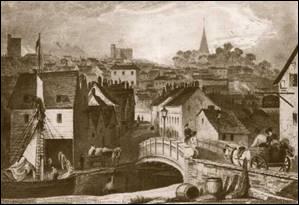
Fullbridge, Maldon
One, somewhat dubious, civic dignitary involved in
smuggling wool was Thomas Fumes who moved to Maldon in 1572. He became a
freeman of the town and from 1576-1585 was Head Burgess, then Alderman and
three times the borough bailiff.
He became involved with another bailiff and native
Maldonian clothier Thomas Clark and they were both accused of smuggling wool to
the Low Countries. Fumes was tenant of the Blue Boar where he appointed a
manager to run the inn while he traded as a bona fide wool factor to cover
their smuggling activities.
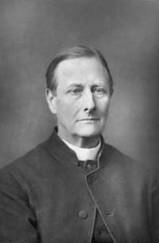
The Reverend Sabine
Baring-Gould, Rector of East Mersea from 1871-1881, chose Mersea Island and the
Blackwater as the setting for his classic novel "Mehalah"
which is based on smuggling and intrigue. The novel is set at the beginning of
the 19th. Century and uses names of people, places and buildings that still
exist to-day.
The Revd. Baring Gould...
In Mehalah we read:
The mouth of the Blackwater was a great centre of
the smuggling trade: the number and intricacies of the channels made it a safe
harbour for those who lived on contraband traffic. It was easy for those who
knew the creeks to elude the revenue boats and every farm and tavern was ready
to give cellerage to run goods and harbour to smugglers. Between Mersea and the
Blackwater were several flat holms or islands...and between these, the winding
waterways formed a labyrinth which made pursuit difficult.
In addition to its
characters, Mehalah also provides the 20th century reader with a
romantic picture of the days of smuggling, when every inn had a false cellar
and coloured lights at night were an almost obligatory sight. A classic
portrayal of both Essex and 19th century life the novel was described at the
time as being 'as good as Wuthering Heights'. Fortunately the area which
Baring-Gould knew, and in which his characters spent their fascinating lives,
has evaded development . The Ray, where Mehalah the heroin lived, is now a
National Trust property and the Strood over which she went looking for
employment at the nearby Peldon Rose Inn, is still frequently subject to
flooding.
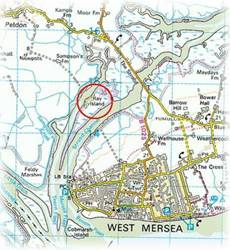
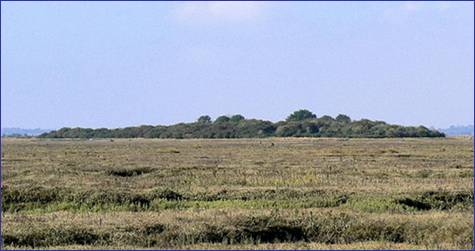
The Ray as seen from the
Strood today
The Revd Baring-Gould wrote:
"The villages of Virley and Salcott were the
chief landing places and there, horses and donkeys were kept in large numbers
for the conveyance of the spirits, wine, tobacco and silk to Tiptree Heath, the
scene of Boadicea's great battle with the legions of Suetonius, which was the
emporium of the trade. There, a constant fair or auction of contraband articles
went on, and thence they were distributed to Maldon, Colchester, Chelmsford or
even London. Tiptree Heath was a permanent camping ground of gipsies, and there
squatters ran up rude hovels; these were engaged in the distribution of goods
brought from the sea."
In 1975 BBC-East made a short programme about smuggling at
Salcott-cum-Virley in which the late Eustace King describes the smugglers
haunts and routes through the village, and showed and described the pond where
contraband was hidden. The pond had a "wooden bottom" so it could be
drained to recover the goods. In more recent years Eustace King became well
known to the residents of Goldhanger and other villages locally as the
undertaker, carpenter and sailor. The programme is now in the East Anglian Film Archive and can be
seen online at: http://www.eafa.org.uk/catalogue/694 (3
minutes long)
Tiptree Heath was long known
as the notorious haunt of gypsies, fugitives from justice, squatters and
smugglers. It was reputed that smuggled goods were stored there in shallow
holes dug in the sandy soil and then covered with turf and brushwood.
Furthermore, smuggled goods were said to have been auctioned during Tiptree
Fair, which during the late 18th century was alleged to have lasted for a
month. Baring-Gould described Tiptree Heath as 'the emporium of the trade'.
Many 'safe' houses in the area were used for storage and the large brick
windmill at Tiptree was reputed used to hide contraband. A pond at Paternoster
Heath, Tolleshunt Knights, was used to conceal half-ankers of spirits. (Early
maps show that both Tiptree and Paternoster Heaths were once much larger areas
of heathland than they are today). It is said there was a tunnel from Tiptree
Priory all the way to Layer Marney Towers, which is a distance of about 7
miles, but perhaps it was a tunnel through the woods.
An extract an article in The
Daily Mail of 1977, written by James Wentworth Day. . .
My grandfather was one of those
that did in the Revenue men in their long boat one night more than 100 years
ago, an ancient fisherman and wild fowler confided to me. The Revenue men had a
watchboat, other side of the river by Stansgate Abbey, Wedgwood Benn's place.
Nearly all the fishing chaps from Maldon, Tollesbury, Mersea, Goldhanger,
Bradwell, Steeple and Mayland were in the Free Trade smuggling. Those Revenue
men were after them day and night. So one day. the smuggling boys held a
meeting in the Old Victory on Mersea island, and planned to do in the Revenue
chaps. They set a rumour that a big cargo was to be run ashore on the seaward
end of Osea In a creek they've called Death Creek ever since. Nobody knows what
did happen that dark night, but next morning they found the Customs long boat
drifting on the tide In the creek with 24 dead Revenue men aboard. And nobody
was ever caught. Those were the bad old days, we don't want murders again.
Death Creek has also been called Cut Throat
Creek and Deadman's Creek.
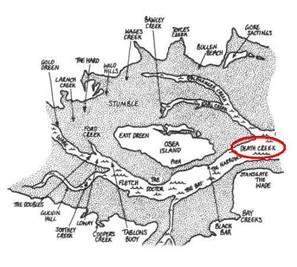
Smuggling at Goldhanger
The first known smuggling
activity at Goldhanger was in 1361 and that was the illegal export of wool,
carried out by 'Owlers'. In the past Goldhanger was sufficiently distant from
Maldon to escape the attentions of all but the most diligent officers stationed
there. A favourite early technique of Goldhanger smugglers was to float rafts
of tubs down the Blackwater, and land them close by at Mill Beach.
In 1898 in the book
entitled: Maldon & the River Blackwater, E A Fitch wrote of
Goldhanger:
One may hear several exciting smugglers tales from the older
inhabitants.
A local newspaper article in
1938 referring to Fish Street was entitles: A
reprieve for Street Smugglers
and text included this
phase: home for centuries of families of
East Coast smugglers.
In Goldhanger - an
Estuary Village, Maura Benham wrote. . .
As the marshes were thought to be
unhealthy there were few big houses and thus few magistrates resident near the
creeks. People living in Goldhanger have heard tales handed down of their
forebears turning a deaf ear to noises at night, and next morning finding their
horses lathered and a keg of brandy in the porch. They say the smugglers had a
depot at Chappel Farm and bound sacking round the wheels of the carts to dull
the sound and over the horses hooves to hide the footprints. The Chequers, the
only alehouse listed in Goldhanger in 1769, may have played a part. The goods
were often stored for a time, and there are stories of using cellars behind the
Chequers, or perhaps in a part of Goldhanger Hall whose whereabouts remain a
mystery.
A tunnel linking the
Chequers with the creek has also been rumoured, which seems unlikely today, but
Maura Benham also suggests that the Creek or a stream leading to it could once
have come very close to the Church. 'providing
a means to bring goods by water to the church, rectory and tithe barn'. We
also know that there was a much longer tunnel connecting the Blue Boar in
Maldon to the river near Beeliegh Abbey, so perhaps a tunnel behind The
Chequers could have existed, it could even have been a tunnel through the woods
to the Creek.
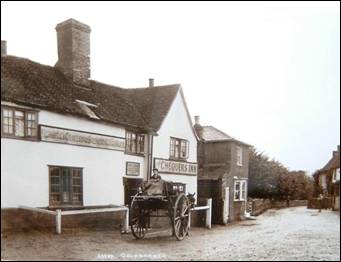 . ..
. .. 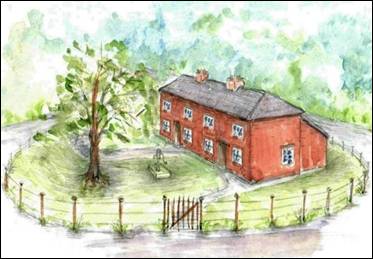
It is said there was a
passage or cellar under the Pitt Cottages that stood on the grass triangle
where the Little Totham Road joins the Maldon road (shown above), and that this
was used for smuggling. An Osborne's bus fell into a hole in the road behind
these cottages in the 1950s and this could have been the passage or cellar. It
was probably one reason why the cottages were demolished. Tiptree Heath was
said to be the 'sorting office', and it is said smugglers went from Fish Street
up Head Street, Blind Lane and Wash Lane, or landing in Joyces creek would
follow the green lane (on the west side of Joyces farmhouse) to Tolleshunt
Major to halt at the church, the Bell Inn or Renters Farm.
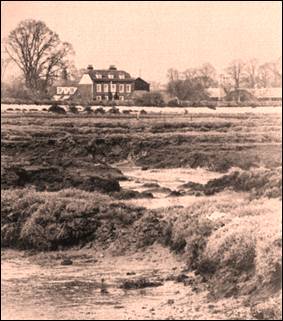
Joyces Creek
From Little Totham: The
Story of a small village . . .
It is said that smugglers
frequently used the route from Goldhanger along Blind Lane up Wash Lane, and
along School Road and The Street to Little Totham Plains and Tiptree Heath.
This route was probably used by smugglers carrying spirits, Bayes and Says
(baize and serge), wine and tobacco. Probably wool and sheep were taken in the
opposite direction. Tiptree Heath and Little Totham Plains were lonely, damp
and wild stretches of country, with a travelling population. These gypsies
worked in association with the smugglers with whom they conducted their
business.
In Smuggling in Essex published
in 2005 Graham Smith wrote. . .
Like most, if not all, villages
along the Blackwater estuary, Goldhanger acquired a smuggling reputation. The
village is about 3 miles to the east of Maldon at the head of a small creek and
was sufficiently distant and hidden away to escape the attention of those few
hard-pressed Customs officers stationed at Maldon. In 1939 Doreen Wallace in
Eastern England described it as 'a diminutive earthly paradise ... Tiny though
it is. . . a road heading seawards to nowhere. . . it is not to be missed. . '.
The village has hardly changed over the centuries, and the Chequers Inn on The
Square, listed as an ale house in 1769, was reputed to have been used for the
storage of smuggled goods in its cellars situated behind the inn.
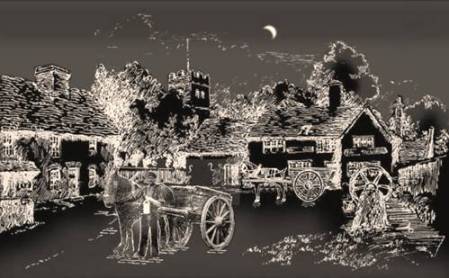
Movements through The Square
at night
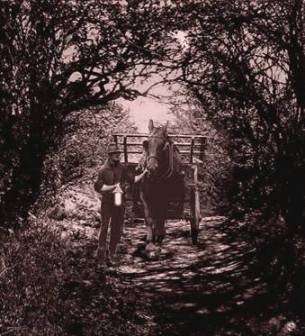
A tunnel-like footpath from
the Creek to the village
In an article entitled Smuggling on the Blackwater published
the East Anglian Magazine Vol XX (1960/1) Roger Frith relates an interview he
had with George Stokes, 'a member of one Goldhanger's oldest families'. . .
In my great-grandmother's time,
she remembered smuggling a lot and my uncle, he lived down Wash Lane. He was a
farmer by the name of Quy... Smugglers, they used ter go up Blind Lane into
Wash Lane and then up to Witham. Or Green Lane, down on the beach, up there,
through Longwick Farm to Tolleshunt Major, either to the church [St Nicholas
overlooking the Blackwater estuary]. The Bell Inn or Retner's Farm. Up Joyces
Creek they'd come and land their Hollands, lace and tobacco and shove the bandy
down cellars at Joyce s Farm. At night my mother used ter tell me they'd ride
up Fish Street carrying brandy on horses whose hooves had been covered with
cloth. But them days has gone. They went about forty years ago with the
fishing.
Well one night someone—he never
found out who—put 20 barrels of brandy in his shed and in the morning it was
found by the Customs. They took him off to the police station but by the time
they got it there, there were only 19 barrels left. He was taken to Chelmsford
Prison, and shoved into a detention cell, although he was quite innocent of the
fact of smuggling. During the time he was there a lunch consisting or either a
partridge or a pheasant was sent to him every day from outside and he never
knew where it came from. Smugglers used to go up Blind Lane into Wash Lane and
then up to Witham. Or Green Lane, down on the beach, up there, through Long
Wick Farm to Tolleshunt Major, either to the church, "The Bell Inn",
or Rentner's Farm. Up Joyce's Creek they'd come and land their Hollands, lace,
and tobacco, and shove the brandy down into the cellars at Joyce's Farm, or
Cobb's.
At night, my mother used to tell
me, they'd ride up Fish Street carrying brandy on horses whose hooves had been
covered with cloth. But them days has gone, they went out about 40 years ago
with the fishing. They're all buried now like my grandfather's stuff under the
gardens of Goldhanger Hall, which was pulled down, yes it's still there.

The Fish Street night run
It is interesting to note
that Stokes mentions Witham. There was a strong tradition that the Spread
Eagle, the town's celebrated coaching inn, had close ties with smuggling. It
was reputed that smuggled goods were stored in a secret well, which could only
be reached through a passage in the roof!
Goldhanger and the Blackwater
Estuary have long been connected with the production of sea salt (see. . . Salt
extraction in the Blackwater), and this trade has also been the
subject of smuggling in the past. Between 1693 and 1835 there was a salt tax in
place which substantially raised the price of domestic salt above its cost and
this led to the smuggling of salt.
A short extract from. . . The Salt Manufacturers
Association: salt tax
The salt tax on home produced
white salt was several times its market value and was twice that on foreign
salt. For fishery salt, the tax was greatly reduced and rock salt was taxed at
a lower rate than white salt.
By the 17th century salt-on-salt
refining developed by the Dutch was being practised by English coastal salt
works using cheap Cheshire grey rock salt and from the 1690s rock salt
refineries were being established to produce a purer white salt until an
extension of the Salt Act prohibited the further expansion of the trade. All
this resulted in the smuggling of salt and other forms of evasion of the salt
tax throughout the life of this tax and it is doubtful whether the revenue
earned justified the enormous cost involved in its administration.
The 1693 Salt Act created
the post of Salt Officer whose role
was similar to that of a Revenue Officer but was specifically to collect the
salt tax at source. Limits were also set on the number of salt processing
locations and in the Maldon area the only licensed site was at Heybridge. The
Heybridge Salt Works operated at Colliers Reach, near Heybridge Basin and much
later moved to Maldon and became the Maldon Crystal Salt Co., while the site in
Heybridge became Saltcote Maltings. As the north bank of the Blackwater Estuary
has been used for salt panning for centuries it is easy to see that smuggling
would have been rife, and isolated villages such as Goldhanger would have been
ideal for the movement smuggled salt along side other free trade items. As the fishery salt being used by the local
fishermen had a much lower tax and was readily available around the estuary,
presumably brought in by barge from Cheshire or France, this could relatively
easily be converted by salt-on-salt
processing in isolated locations. Although no records of illegal salt
production or salt smuggling in the village have been identified, it seems no
coincidence that the salt tax was repealed in 1825 and last recorded salt
production at Bounds Farm, Goldhanger was just a few years later in the 1830s.
There has been a more recent
example of smuggling at Goldhanger and in the Blackwater. At the beginning of
the 20th century, the brewer F H Charington, purchased Osea Island to used as resort for their landlords. It was
intended to be an isolated drying out
venue for those had excessively participated in the company's products.
Unfortunately, the resort did not operate for many years, one reason being that
the inmates continued to be regularly supplied with alcohol from The Chequers
at Goldhanger. Smugglers would row across to the island and tied bottles of
spirits to the Doctor's Buoy close to the island for later collection. The
Doctor's Buoy can still be found on navigation maps.
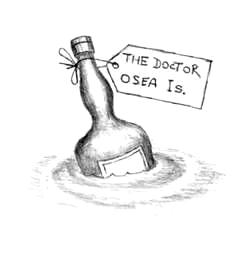
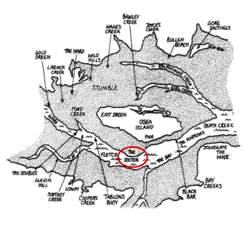
The Goldhanger Coastguards
The Coastguard Service was created in 1822 with the amalgamation of the Preventive Water Guard, the Revenue Cruisers and the Riding Officers, and in 1831 the Coast Blockade was also absorbed as all these departments duties overlapped. The Coastguard Service employed almost 6,700 men at the time of amalgamation. A modem Dictionary gives the definition of "Coastguard" as "An organisation with responsibility for watching coastal waters, to prevent smuggling, illegal fishing, to assist shipping, and for life saving". It is said that the everyday saying "is the coast clear?" originates from smuggling, meaning "are there any coastguards about?"
Once employed as a
coastguard it was necessary for an officer and his family to move away from
family roots to avoid any conflict of interest. However, until the familiar
blocks of Coastguard cottages were built during the second half of the
nineteenth century, coastguards and their families were accommodated in rented
houses in towns and villages round the coast. Hulks were also moored in the
creeks of Essex to accommodate the coastguard men with their families,although
not it seems at Goldhanger. They were known to been at Stansgate, Bradwell,
Burnham and Paglesham...
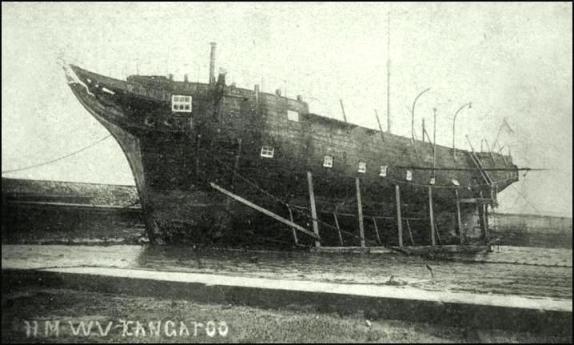
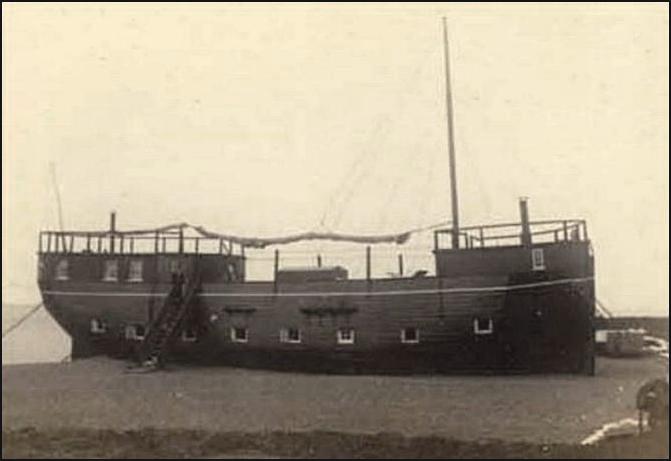
Watch Vessel “Kangaroo” at
Burnham
Watch Vessel “Frolic” at Stansgate
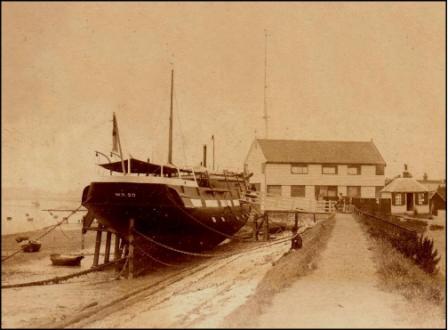
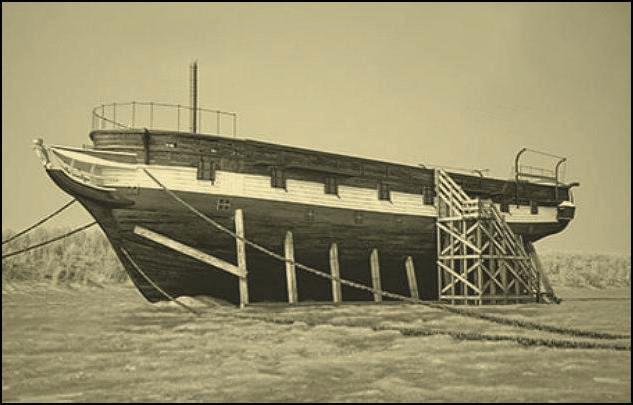
Watch Vessel 20 at
Burham
HMS Beagle hulk WV-7 at Paglesham (reconstruction)
The first reference to
coastguards in Goldhanger was in 1822. The details are in a book entitled
"A gin at Government House" which contain the memoirs of one
Agnes Stokes who was born in 1867. She related stories told by her mother of
her grandfather, a coastguard, who brought the family of nine children from
Walton-on-the-Naze to Goldhanger in a government cutter and a large sailing
vessel, which had a rough passage, which is a distance of about 25 miles around
the coast. They arrived late at night, and beds needed to be found for the nine
children in several houses. The Census returns of 1851 show a family headed by
Joseph Sherrells, 34 and his wife Alice, 26 and baby living in Fish Street,
giving his occupation as being boatman/coastguard.
By 1861 there were four
families whose head describe their occupation as the coastguard service, their
residence is only described as The Street
and was probably what is now 32 & 32A Fish St. The Census shows that in
1871 there were again four families who describe their head occupation as
"coastguards". Two families show their address as being Fish Street
while the others reside in Church Street. The Coastguard Service decreed that
officers could not operate in their own area and had to move away from home,
hence accommodation was needed close to their posting. Between 1867 and 1873
the Revd. H.F. Coape-Arnold from Warwickshire (not a Goldhanger Rector)
inherited land from Henry Coe Coape and build a pair of
redbrick cottages in Church street. The left-hand cottage in Church St. being
built as an armoury with adjoining internal doors. In 1875 he built another
pair of cottages to the right side making a terrace of four...
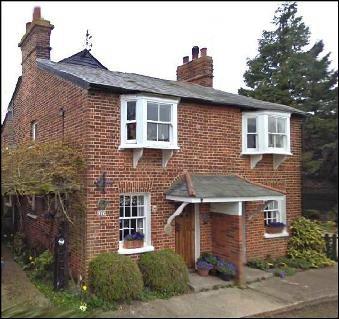
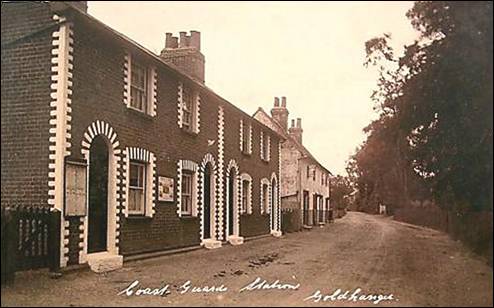
the Coastguard cottages with navy notice boards
outside the armoury of the Church St. block
In 1881 the Census still
shows four families living in Goldhanger who's head occupation is given as
coastguard, two still living in Fish street while the other two lived in Church
street, presumably in the newly built Coastguard Cottages. By 1891 there were
only three families whose head occupant were coastguards, and they all lived in
the Coastguard Cottages in Church Street. Today more that thirty coastguards
can be identified in www.genuki.org.uk/big/Coastguards as living in the
coastguard cottages at Goldhanger between 1850 and 1901.
The coastguards maintained a
hut and flagstaff on the seawall near to Bounds Farm. The 1890s map on the left
below shows the Coastguard Station at the head of the Creek. Another 1980s map
in the centre below clearly shows the coastguard station on the seawall in the
same position as today's Sailing Club “starting hut” and adjacent to the
original Goldhanger saltworks site. the postcard photograph
from the 1920s shows the the hut with the flagstaff for communicating with
other coastguard stations on the Blackwater...
two 1890s maps with the huts
shown in different locations, and a 1920s photo of the coastguard hut on the
seawall
Here is an extract from a 1886 sale catalogue (ERO
D/F 63/1/10/6)
Bounds Farm, Goldhanger
Comprising farmhouse, farm buildings,
double tenement cottage with garden and bakehouse
and about 205 acres of arable and
pasture land. With plan.
Includes manuscript note that the Coast
Guard flag staff stands upon Lot 2 (Bounds Farm)
and the Government pays 10s. per annum
rent.
There is a shelter hut of the Coast
Guard for which they pay 6d per annum,
and the Fishermen agree to pay 5s. per annum for the use of the Pits and Drying ground on the foreshore.
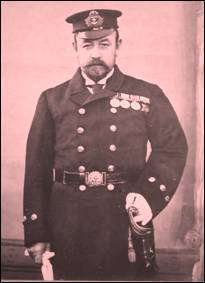
John Veitch, Head Coastguard
stationed at Goldhanger in
1901
The coastguards on the
Blackwater and other Essex estuaries maintained an impressive fleet of high
speed cutters. Again, there is no record of any being permanently based at
Goldhanger, but we know they came here from reports of Goldhanger Regattas in the late 1800s. Cutters referred to
in those reports that took part in races were The Widgeon, The Fly and The
Rhine. Here are two images of coastguard cutters that were known to be based at
Bradwell...
|
|
|
|
excise cutter Fly based at Bradwell in the 1790s & 1800s, |
excise cutter Badger based at Bradwell, perhaps even earlier |
These cutters were renowned for apprehending smugglers in the
Blackwater, Colne, Crouch and Roach estuaries
We do not know how well the
coastguards integrated to into village life, but the is at least one family of
descendants of a coastguard still in the village, and the picture of the
Friendly Brothers taken at The Chequers in 1910 shows possibly a coastguard
sitting in the group and could have been a member...
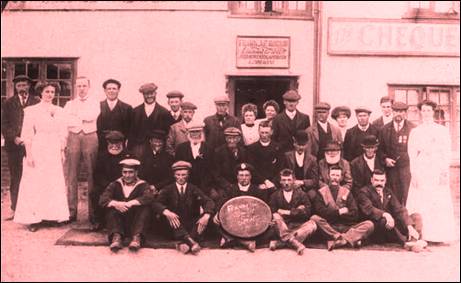
The Friendly Brothers in 1910
with possibly a coastguard in the group
The cottages have been much
modified since that time. Originally, the ground floor and upper floor provided
separate accommodation. The upper floor was reached by an external metal and wooden
veranda with a balustrade that ran along the rear wall, with an open staircase
at one end, which would have made the building look much more like military
barracks. The small piece of open ground at the southern end was a parade
ground, known then as The Court
(which today has a house built on it). The men would form up here at the
beginning of their duties and march at arms and with the flag down thought the
village to the coastguard hut on the seawall. This would have been a formidable
sight. No photograph of this activity have been found but similar scenes were
recorded at Tollesbury and Mersea.
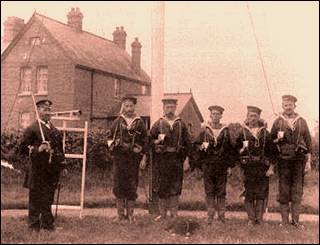
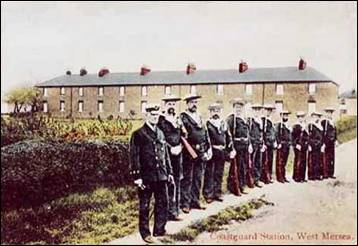
Tollesbury Coastguards on
parade in 1900
Mersea Coastguards on parade in 1906
At the end of the Great War
the Coastguard Service was wound down, and in 1920 the Revd. H.F. Coape-Arnold,
who owned the Goldhanger Coastguard Cottages, put them up for auction and they
become private houses.
